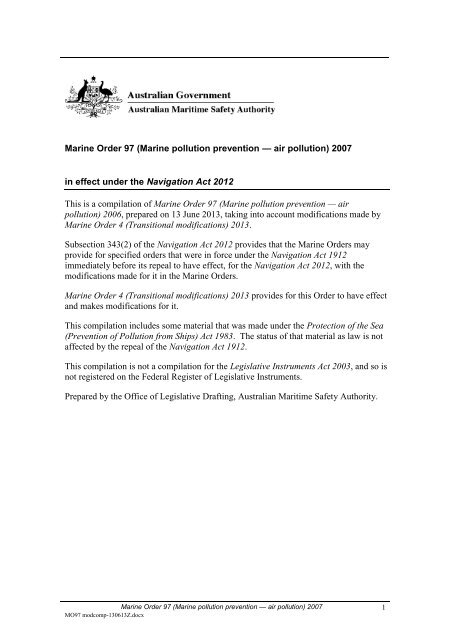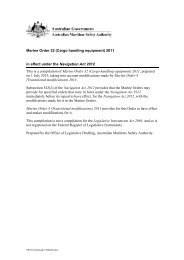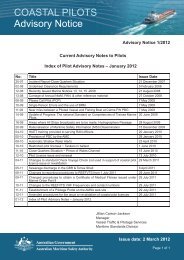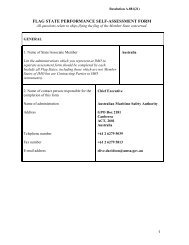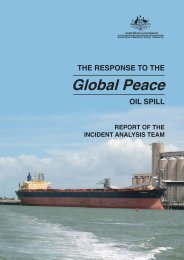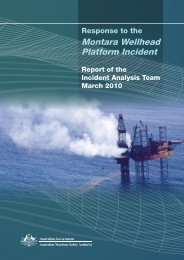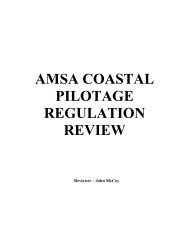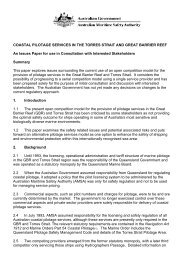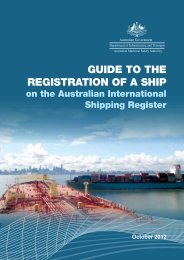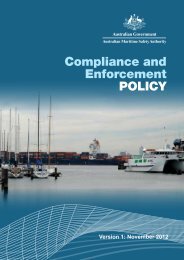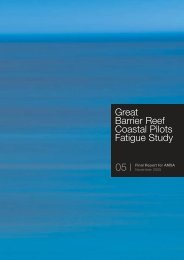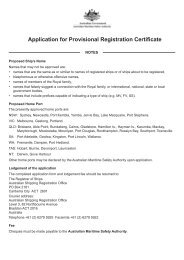Marine pollution prevention — air pollution - Australian Maritime ...
Marine pollution prevention — air pollution - Australian Maritime ...
Marine pollution prevention — air pollution - Australian Maritime ...
Create successful ePaper yourself
Turn your PDF publications into a flip-book with our unique Google optimized e-Paper software.
<strong>Marine</strong> Order 97 (<strong>Marine</strong> <strong>pollution</strong> <strong>prevention</strong> <strong>—</strong> <strong>air</strong> <strong>pollution</strong>) 2007in effect under the Navigation Act 2012This is a compilation of <strong>Marine</strong> Order 97 (<strong>Marine</strong> <strong>pollution</strong> <strong>prevention</strong> <strong>—</strong> <strong>air</strong><strong>pollution</strong>) 2006, prepared on 13 June 2013, taking into account modifications made by<strong>Marine</strong> Order 4 (Transitional modifications) 2013.Subsection 343(2) of the Navigation Act 2012 provides that the <strong>Marine</strong> Orders mayprovide for specified orders that were in force under the Navigation Act 1912immediately before its repeal to have effect, for the Navigation Act 2012, with themodifications made for it in the <strong>Marine</strong> Orders.<strong>Marine</strong> Order 4 (Transitional modifications) 2013 provides for this Order to have effectand makes modifications for it.This compilation includes some material that was made under the Protection of the Sea(Prevention of Pollution from Ships) Act 1983. The status of that material as law is notaffected by the repeal of the Navigation Act 1912.This compilation is not a compilation for the Legislative Instruments Act 2003, and so isnot registered on the Federal Register of Legislative Instruments.Prepared by the Office of Legislative Drafting, <strong>Australian</strong> <strong>Maritime</strong> Safety Authority.<strong>Marine</strong> Order 97 (<strong>Marine</strong> <strong>pollution</strong> <strong>prevention</strong> <strong>—</strong> <strong>air</strong> <strong>pollution</strong>) 2007 1MO97 modcomp-130613Z.docx
ContentsPage1A Name of Order ....................................................................................................... 31 Purpose & power ................................................................................................... 32 Definitions .............................................................................................................. 43 Interpretation .......................................................................................................... 54 Application ............................................................................................................. 55 Equivalents ............................................................................................................ 57 Surveys .................................................................................................................. 68 Certificates ............................................................................................................. 89 Nitrogen oxides .................................................................................................... 1010 Shipboard incineration ......................................................................................... 1311 Matters prescribed for the Navigation Act ........................................................... 1412 Matters prescribed for the purposes of the Pollution Prevention Act .................. 14Schedule 1 Forms ................................................................................................... 182 <strong>Marine</strong> Order 97 (<strong>Marine</strong> <strong>pollution</strong> <strong>prevention</strong> <strong>—</strong> <strong>air</strong> <strong>pollution</strong>) 2007MO97 modcomp-130613Z.docx
Section 11AName of OrderThis Order is <strong>Marine</strong> Order 97 (<strong>Marine</strong> <strong>pollution</strong> <strong>prevention</strong> <strong>—</strong><strong>air</strong><strong>pollution</strong> 2007.1 Purpose & power1.1 PurposeThis Order:(a) gives effect to, whole or part of, Regulations 5, 6, 8, 9, 13, 14, 16 and 18 ofAnnex VI of MARPOL which deal with survey and certification, emissionlimits for nitrogen oxides (NOx) and sulphur oxides (SOx), shipboardincineration, fuel oil sampling and record keeping matters; and(b) gives effect to Chapter 4 of the Navigation Act and prescribes matters forDivision 2 of Part IIID of the Pollution Prevention Act.1.2 Power1.2.1 Subsection 339(1) of the Navigation Act provides for regulations to be madeprescribing matters required or permitted to be prescribed, or which arenecessary or convenient to be prescribed for carrying out or giving effect to theAct. Paragraph 340(1)(c) of the Navigation Act provides that the regulationsmay make provision for and in relation to giving effect to Regulations 5, 6, 8, 9,13 and 16 of Annex VI of MARPOL.1.2.1A Subsection 130(1) of the Navigation Act provides that the regulations may makeprovision about <strong>pollution</strong> certificates.1.2.1B Subsection 314(3) of the Navigation Act provides that the regulations mayprescribe various matters about certificates, including the time when certificates,variations of certificates and revocation of certificates come into force.1.2.1C Subsection 341(1) of the Navigation Act provides that the regulations mayprovide for the imposition of penalties and civil penalties for a contravention ofthe regulations or a notice, order, direction or instruction given, issued or madeunder, or in force because of, the regulations.1.2.2 Subsection 33(1) of the Pollution Prevention Act provides for regulations to bemade prescribing matters:(a) required or permitted to be prescribed; or(b) necessary or convenient to be prescribed for carrying out or giving effect tothe Act;and, in particular:(c) for and in relation to giving effect to MARPOL, other than provisions ofMARPOL to which effect is given by a provision of the PollutionPrevention Act, any other Act or any instrument made under any other Act.1.2.3 Subsection 342(1) of the Navigation Act provides that AMSA may make ordersfor any matter for which provision must or may be made by regulation.<strong>Marine</strong> Order 97 (<strong>Marine</strong> <strong>pollution</strong> <strong>prevention</strong> <strong>—</strong> <strong>air</strong> <strong>pollution</strong>) 2007 3MO97 modcomp-130613Z.docx
Section 21.2.4 Subsection 34(1) of the Pollution Prevention Act provides that AMSA maymake orders for any matter (other than the imposition of penalties) for whichprovision may be made by regulation.2 Definitionsanniversary date, in relation to an IAPP Certificate, means the day and month ofeach year which corresponds to the date of expiry of the certificate.Annex VI means Annex VI of MARPOL.date of issue, in relation to a certificate, means:(a) the date that the certificate is issued; or(b) the date shown on the certificate as the date of issue for the purposes ofAnnex VI, being a date not earlier than the date on which the survey for theissue of the certificate was completed,whichever is the earlier.EIAPP certificate (or Engine International Air Pollution Preventioncertificate) means:(a) a <strong>pollution</strong> certificate relating to <strong>air</strong> <strong>pollution</strong> or ozone depleting substancesissued under section 132 of the Navigation Act for engines and equipmentof a vessel; or(b) a certificate relating to Annex VI issued under section 319 of theNavigation Act for engines and equipment of a vessel.Note For the form of certificate <strong>—</strong> see subsection 8.1A.7.IAPP certificate (or International Air Pollution Prevention certificate) means:(a) a <strong>pollution</strong> certificate relating to <strong>air</strong> <strong>pollution</strong> or ozone depleting substancesissued under section 132 of the Navigation Act for a vessel; or(b) a certificate relating to Annex VI issued under section 319 of theNavigation Act for a vessel.Note For the form of certificate <strong>—</strong> see subsection 8.1A6.North American area means the North American Emission Control Area asdefined in Appendix VII to Annex VI.NOx Technical Code has the same meaning as in Annex VI.Note 1 Some expressions used in this Order are defined in <strong>Marine</strong> Order 1(Administration) 2011 including:Area ManagerGeneral ManagerIMOManager, Ship Inspection and RegistrationMARPOLNavigation Act Pollution Prevention Act.Note 2 Some terms used in this Order are defined in the Navigation Act or Pollution PreventionAct, including:AMSAinspector recognised organisation (for organisations that have been prescribed for the definition <strong>—</strong>see <strong>Marine</strong> Order 1 (Administration) 2011)4 <strong>Marine</strong> Order 97 (<strong>Marine</strong> <strong>pollution</strong> <strong>prevention</strong> <strong>—</strong> <strong>air</strong> <strong>pollution</strong>) 2007MO97 modcomp-130613Z.docx
Section 5regulated <strong>Australian</strong> vessel.3 Interpretation3.1 A reference in the NOx Technical Code to the Administration is to be taken tomean, in relation to a vessel registered in Australia, the Manager, ShipInspection and Registration, or a recognised organisation.Note Information on obtaining copies of IMO Resolutions or other documents referred to inthis Order is available from AMSA.4 Application4.1 Subject to subsection 33(2) of the Pollution Prevention Act and section 12 of theNavigation Act, this Order applies to:(a) a non-foreign vessel:(i) to which Annex VI is expressed to apply; or(ii) owned or operated by the Commonwealth and used, for the time being,on government non-commercial service; and(b) a foreign vessel to which Annex VI is expressed to apply.Note 1 The legislation mentioned in subsection 4.1 provides, in effect, that this Order does notapply to certain vessels to which MARPOL applies because of a law of a State or the NorthernTerritory or the <strong>Maritime</strong> Safety (Domestic Commercial Vessel) National Law.Note 2 A provision of this Order made under the Navigation Act affects foreign vessels only tothe extent that it is expressed to apply to foreign vessels.4.1A For subsection 4.1, each of the following is a non-foreign vessel:(a) a regulated <strong>Australian</strong> vessel;(b) a domestic commercial vessel;(c) a recreational vessel that has <strong>Australian</strong> nationality.4.2 Sections 7 and 8 do not apply to a foreign vessel, except to the extent necessaryto enable the issue of an IAPP Certificate under section 319 of the NavigationAct.5 Equivalents5.1 This provision applies if:(a) a provision of this Order, or Annex VI, requires:(i) fitting in a vessel of a particular fitting, material, appliance or apparatus(the required thing); or(ii) use of a particular procedure, fuel oil or compliance method (therequired usage); and(b) an alternative to the required thing or required usage (an equivalent) isavailable that:(i) could be fitted in a vessel, or used, instead of the required thing orrequired usage; and(ii) may be at least as effective if fitted in the vessel, or used, as therequired thing or required usage; and(c) the owner or operator of a vessel wants to fit in the vessel, or use, theequivalent.<strong>Marine</strong> Order 97 (<strong>Marine</strong> <strong>pollution</strong> <strong>prevention</strong> <strong>—</strong> <strong>air</strong> <strong>pollution</strong>) 2007 5MO97 modcomp-130613Z.docx
Section 75.2 The owner or operator may apply, in accordance with the application process setout in <strong>Marine</strong> Order 1 (Administration) 2011 for approval for an equivalent tobe fitted or used.5.3 The decision maker for an application made under subsection 5.2 is theManager, Ship Inspection and Registration.Note <strong>Marine</strong> Order 1 (Administration) 2011 deals with the following:7 Surveysmaking of an applicationseeking further information about an applicationthe time allowed for consideration of an applicationnotification of a decision on an applicationreview of decisions[MARPOL VI-5]7.1 Survey requirementsEvery vessel of 400 gross tonnage and above is subject to the following surveysand inspections:(a) an initial survey before the vessel is put in service or before an IAPPCertificate is issued for the first time;(b) subject to subsections 8.2, 8.3.3, 8.3.4 and 8.3.5, a renewal survey atintervals not exceeding 5 years after the completion of the initial survey;(c) an intermediate survey within 3 months before or after the secondanniversary date or within 3 months before or after the third anniversarydate of the IAPP Certificate, which will take the place of one of the annualsurveys;(d) an annual survey within 3 months before or after each anniversary date ofthe IAPP Certificate; and(e) additional surveys, as occasion arises.7.2 Initial surveyThe initial survey must include a complete survey of its equipment, systems,fittings, arrangements and material in so far as such is required by, or providedfor the purposes of, Annex VI. This survey must be such as to ensure that theequipment, systems, fittings, arrangements and material fully comply with theapplicable requirements of Annex VI.7.3 Renewal surveysEach renewal survey must be such as to ensure that the equipment, systems,fittings, arrangements and material fully comply with the applicablerequirements of Annex VI.7.4 Intermediate surveysEach intermediate survey must be such as to ensure that the equipment andarrangements fully comply with the applicable requirements of Annex VI andare in good working order.6 <strong>Marine</strong> Order 97 (<strong>Marine</strong> <strong>pollution</strong> <strong>prevention</strong> <strong>—</strong> <strong>air</strong> <strong>pollution</strong>) 2007MO97 modcomp-130613Z.docx
Section 77.5 Annual surveysEach annual survey must include a general inspection of the equipment,systems, fittings, arrangements and material referred to in subsection 7.2 toensure that they have been maintained in accordance with subsection 7.9.7.6 Additional surveysAn additional survey, either general or partial, according to the circumstances,must be made after a rep<strong>air</strong> resulting from investigations referred to insubsection 7.9.3, or whenever any important rep<strong>air</strong>s or renewals are made. Thesurvey must be such as to ensure that the necessary rep<strong>air</strong>s or renewals havebeen effectively made, that the material and workmanship of such rep<strong>air</strong>s orrenewals are in all respects satisfactory, and that the vessel complies in allrespects with the provisions of Annex VI.7.7 Endorsement of certificatesThe intermediate and annual surveys must be endorsed on the IAPP Certificate.7.8 Emission of nitrogen oxides from enginesThe requirements for the issue of an EIAPP certificate for engines andequipment are that the engines and equipment:(a) are surveyed in accordance with the NO x Technical Code 2008; and(b) are found to comply with Regulation 13 of Annex VI.Note See also IMO Resolution MEPC.103(49): Guidelines for on-board NOx verificationprocedure <strong>—</strong> direct measurement and monitoring method.7.9 Maintenance of condition7.9.1 The condition of the equipment of a vessel must be maintained to conform withthe provisions of Annex VI.7.9.2 After any survey of a vessel has been completed, no change is to be made in theequipment, systems, fittings, arrangements or material covered by the survey,without the sanction of the Manager, Ship Inspection and Registration, exceptthe direct replacement of such equipment and fittings.7.9.3 Whenever an accident occurs to a vessel or a defect is discovered whichsubstantially affects the efficiency or completeness of its equipment covered byAnnex VI, the master or, if the master is unable to do so, the operator of thevessel must report at the earliest opportunity to the Manager, Ship Inspectionand Registration, who will cause investigations to be initiated to determinewhether a survey under subsection 7.6 is necessary.Penalty: 50 penalty units.7.9.4 An offence against subsection 7.9.3 is a strict liability offence.7.9.5 A person is liable to a civil penalty if the person contravenes subsection 7.9.3.Civil penalty: 50 penalty units7.9.6 If the vessel is at sea or at a port outside Australia, the report mentioned insubsection 7.9.3 must be made to the Manager, Ship Inspection andRegistration, through the Rescue Coordination Centre (RCC) Australia.Note Contact details for the RCC are: telephone: +61 (0)2 6230 6811; freecall: 1800 641 792(within Australia); facsimile: +61 (0)2 6230 6868; AFTN: YSARYCYX; e-mail:rccaus@amsa.gov.au.<strong>Marine</strong> Order 97 (<strong>Marine</strong> <strong>pollution</strong> <strong>prevention</strong> <strong>—</strong> <strong>air</strong> <strong>pollution</strong>) 2007 7MO97 modcomp-130613Z.docx
Section 87.9.7 If the vessel is at a port outside Australia, the master must also report theaccident or defect to the appropriate authority of the country where the port issituated.8 Certificates[MARPOL VI-9]8.1A Preliminary matters about IAPP certificates8.1A.1 For subsection 130(3) of the Navigation Act (which enables the regulations toprovide that specified vessels are required to have specified <strong>pollution</strong>certificates), a vessel to which this Order applies must have an IAPP certificate.8.1A.2 For subsection 131(1) of the Navigation Act (which enables a person to apply toan issuing body for a <strong>pollution</strong> certificate of a kind specified in the regulations),an IAPP certificate and an EIAPP certificate are specified for a vessel to whichthis Order applies.8.1A.3 For section 132 of the Navigation Act (which enables criteria to be prescribedfor the issue of a <strong>pollution</strong> certificate), the criteria for issue of an IAPPcertificate for a vessel are that the vessel:(a) complies with Regulation 5 of Annex VI; and(b) has been surveyed in accordance with section 7; and(c) complies with the requirements that apply to it under section 7.8.1A.4 For section 133 of the Navigation Act (which enables criteria to be prescribedfor the variation of a <strong>pollution</strong> certificate), the criteria for variation of an IAPPcertificate for a vessel are that:(a) the vessel has been surveyed in accordance with section 7; and(b) the vessel complies with the requirements that apply to it under section 7;and(c) the variation is in accordance with subsections 8.3 and 8.4.8.1A.5 The form of an IAPP certificate is the International Air Pollution PreventionCertificate set out in Appendix I to Annex VI.8.1A.6 The form of an EIAPP certificate is the Engine International Air PollutionPrevention Certificate set out in Appendix I to the NO x Technical Code 2008.Note A new certificate for a ship transferring to the <strong>Australian</strong> flag will not be issued until anissuing body is satisfied that the ship complies with Annex VI.8.1 Duration of certificatesAn IAPP Certificate remains valid:(a) in the case of the first issue of a certificate<strong>—</strong>for a period of 5 years from thedate of issue; or(b) in the case of a renewed certificate <strong>—</strong> for a period of 5 years from theappropriate commencement date specified in subsection 8.2; or(c) for such lesser period as the certificate specifies,unless earlier revoked.Note See subsection 8.1A.4 for circumstances in which an an IAPP certificate may be varied toextend its period of validity.8 <strong>Marine</strong> Order 97 (<strong>Marine</strong> <strong>pollution</strong> <strong>prevention</strong> <strong>—</strong> <strong>air</strong> <strong>pollution</strong>) 2007MO97 modcomp-130613Z.docx
Section 88.2 Commencement of renewal periodIf an existing IAPP Certificate is being renewed, the period in subsection 8.1commences:(a) if the renewal survey is completed on, or within 3 months before, the expirydate of the existing certificate <strong>—</strong> from the expiry date of the existingcertificate;(b) if the renewal survey is completed after the expiry date of the existingcertificate <strong>—</strong> from the expiry date of the existing certificate;(c) if the renewal survey is completed more than 3 months before the expirydate of the existing certificate <strong>—</strong> from the date of completion of therenewal survey.8.3 Variation of certificate to extend validity8.3.1 If an IAPP Certificate is issued or renewed for a period of less than 5 years, theManager, Ship Inspection and Registration, may extend the validity of thecertificate beyond the expiry date for a period not exceeding 5 years from thedate of issue or renewal.8.3.2 If a renewal survey has been completed and a new IAPP Certificate cannot beissued or placed on board the vessel before the expiry date of the existingcertificate, the Manager, Ship Inspection and Registration, or recognisedorganisation, as appropriate, must endorse the existing certificate and such acertificate is to be accepted as valid for a further period which must not exceed 5months from the expiry date.8.3.3 If a non-foreign vessel at the time when an IAPP Certificate expires is not in aport in which it is to be surveyed, the Manager, Ship Inspection andRegistration, or a consul or other diplomatic representative of Australia mayextend the period of validity of the certificate but this extension is to be grantedonly for the purpose of allowing the vessel to complete its voyage to the port inwhich it is to be surveyed, and then only in cases where it appears proper andreasonable to do so. No certificate is to be extended for a period longer than3 months, and a vessel to which an extension is granted must not, on its arrivalin the port in which it is to be surveyed, be entitled by virtue of such extensionto leave that port without having a new certificate. When the renewal survey iscompleted, the new certificate is to be valid to a date not exceeding 5 years fromthe date of expiry of the existing certificate before the extension was granted.8.3.4 An IAPP certificate that has been issued to a vessel engaged on short voyages,and that has not been extended under subsection 8.3.1 or 8.3.3, may be extendedby the Manager, Ship Inspection and Registration, or a consul or otherdiplomatic representative of Australia for a period of grace of up to 1 monthfrom the date of expiry stated on it. When the renewal survey is completed, thenew certificate is to be valid to a date not exceeding 5 years from the date ofexpiry of the existing certificate before the extension was granted.8.3.5 In special circumstances, as determined by the Manager, Ship Inspection andRegistration, a new IAPP Certificate need not be dated from the date of expiryof the existing certificate as required by subsection 8.2, 8.3.3 or 8.3.4. In thesespecial circumstances the new certificate is to be valid to a date not exceeding5 years from the date of completion of the renewal survey.<strong>Marine</strong> Order 97 (<strong>Marine</strong> <strong>pollution</strong> <strong>prevention</strong> <strong>—</strong> <strong>air</strong> <strong>pollution</strong>) 2007 9MO97 modcomp-130613Z.docx
Section 9Note “Special circumstances” might include a situation where a vessel is laid up at the time thesurvey is due and remains laid up for a period of 6 months or more.8.4 Surveys completed before certificate expiryIf an annual or intermediate survey is completed before the period specified insection 7, then:(a) the anniversary date shown on the certificate is to be amended byendorsement to a date which must not be more than 3 months later than thedate on which the survey was completed;(b) the subsequent annual, intermediate or periodical survey required bysection 7 must be completed at the intervals specified in section 7 using thenew anniversary date; and(c) the expiry date may remain unchanged provided one or more annual orintermediate surveys, as appropriate, are carried out so that the maximumintervals between the surveys specified in section 7 are not exceeded.8.5 Criteria for revocation of certificateFor section 134 of the Navigation Act (which enables criteria to be prescribedfor the revocation of a <strong>pollution</strong> certificate), the criteria for revocation of anIAPP certificate for a vessel are that:(a) a survey required by section 7 at a particular time is not completed whenrequired by section 7; or(b) the vessel to which it applies ceases to be registered in Australia.Note A new certificate is required for a ship transferring to the <strong>Australian</strong> flag and will not beissued until AMSA or a survey authority, as appropriate, is fully satisfied that the ship is incompliance with the requirements of Annex VI. Section 267ZZB of the Navigation Actprovides that a certificate ceases to have effect if the ship ceases to be an <strong>Australian</strong> ship.9 Nitrogen oxides[MARPOL VI-13]9.1 ScopeSubsections 9.2 and 9.3 apply to the operation of a marine diesel engine towhich:(a) Annex VI, regulation 13, applies; and(b) subsection 9.4, 9.5 or 9.6 does not apply.9.2 General rule about emission levels9.2.1 A person may operate a marine diesel engine installed on a vessel of a kindmentioned in the following table only if the total weighted emissions of nitrogenoxides from the engine is within the limits mentioned in the table for the item.Item Kind of vessel Limits of emissions1 Vessel constructedafter 31 December1999 and before1 January 2011(a) for n < 130 rpm <strong>—</strong> 17.0 g per kWh;(b) for 2 000 rpm > n ≥130 rpm <strong>—</strong> 45.0 × n (-0.2) g perkWh;(c) for n ≥ 2 000 <strong>—</strong> 9.8 g per kWhNote Item 1 reflects requirements called Tier 1 requirements in MARPOL, Annex VI, r 13.10 <strong>Marine</strong> Order 97 (<strong>Marine</strong> <strong>pollution</strong> <strong>prevention</strong> <strong>—</strong> <strong>air</strong> <strong>pollution</strong>) 2007MO97 modcomp-130613Z.docx
Section 9Item Kind of vessel Limits of emissions2 Vessel constructedafter 31 December2010 other than avessel to which item3 applies(a) for n < 130 rpm <strong>—</strong> 14.4 g per kWh;(b) for 2 000 rpm > n ≥130 rpm <strong>—</strong> 44.0 × n (-0.23) g perkWh;(c) for n ≥ 2 000 <strong>—</strong> 7.7 g per kWhNote Item 2 reflects requirements called Tier 2 requirements in MARPOL, Annex VI, r 13.3 Vessel constructedafter 31 December2015 that is withinan emission controlarea(a) for n < 130 rpm <strong>—</strong> 3.4 g per kWh;(b) for 2 000 rpm > n ≥130 rpm <strong>—</strong> 9.0 × n (-0.2) g perkWh;(c) for n ≥ 2 000 <strong>—</strong> 2.0 g per kWhNote Item 3 reflects requirements called Tier 3 requirements in MARPOL, Annex VI, r 13.Penalty: 50 penalty units.9.2.1A An offence against subsection 9.2.1 is a strict liability offence.9.2.1B A person is liable to a civil penalty if the person contravenes subsection 9.2.1.Civil penalty: 50 penalty units9.2.2 In provision 9.2.1:emission control area means the North American area.n, for a marine diesel engine, is the rated engine speed (in crankshaft revolutionsper minute).9.3 Large engines installed on vessels constructed after 31 December 1989and before 1 January 20009.3.1 Subsection 9.3.2 applies to a marine diesel engine:(a) with a power output of more than 5 000 kilowatts; and(b) with a displacement of at least 90 litres per cylinder; and(c) installed on a vessel constructed after 31 December 1989 and before1 January 2000.9.3.2 A person may operate the marine diesel engine only if the total weightedemissions of nitrogen oxides from the engine is within the following limits:(a) for n < 130 rpm <strong>—</strong> 17.0 g per kWh;(b) for 2 000 rpm > n ≥130 rpm <strong>—</strong> 45.0 × n (-0.2) g per kWh;(c) for n ≥ 2 000 <strong>—</strong> 9.8 g per kWh.Penalty: 50 penalty units.9.3.2A An offence against subsection 9.3.2 is a strict liability offence.9.3.2B A person is liable to a civil penalty if the person contravenes subsection 9.3.2.Civil penalty: 50 penalty units9.3.3 In subsection 9.3.2:n, for a marine diesel engine, is the rated engine speed (in crankshaft revolutionsper minute).9.3.4 Subsection 9.3.2 does not apply to a marine diesel engine installed on a vesselif:<strong>Marine</strong> Order 97 (<strong>Marine</strong> <strong>pollution</strong> <strong>prevention</strong> <strong>—</strong> <strong>air</strong> <strong>pollution</strong>) 2007 11MO97 modcomp-130613Z.docx
Section 9(a) no method of modifying the engine in accordance with the NOx TechnicalCode has been approved by a country to which Annex VI applies andnotified to IMO; or(b) both:(i) a method of modifying the engine in accordance with the NOxTechnical Code has been approved by a country to which Annex VIapplies and notified to IMO; and(ii) either:(A) the vessel has not been required to undergo a renewal survey within12 months after the day of the notification; or(B) the Manager, Ship Inspection and Registration has certified that amethod of modifying the engine is not commercially available.Note Information on methods of modifying engines that have been approved by IMO isobtainable from AMSA.9.4 Engines in certain vessels not undertaking overseas voyages <strong>—</strong> generalrule does not apply9.4.1 Item 1 in the table in subsection 9.2.1 and subsection 9.3.2 do not apply to amarine diesel engine installed in a non-foreign vessel that:(a) was constructed or underwent a major conversion (within the meaning ofparagraph 2.1 of regulation 13 in Annex VI) before 10 November 2007; and(b) does not undertake overseas voyages.Note for paragraph (a) Annex VI entered into force for Australia on 10 November 2007.9.4.2 Item 2 in the table in subsection 9.2.1 and subsection 9.3.2 do not apply to amarine diesel engine installed in a non-foreign vessel that:(a) was constructed or underwent a major conversion (within the meaning ofregulation 2.1 in Annex VI) before 1 January 2011; and(b) does not undertake overseas voyages.9.5 Exhaust gas cleaning system <strong>—</strong> general rule does not apply9.5.1 Sections 9.2.1 and 9.3.1 do not apply to a marine diesel engine if an exhaust gascleaning system approved by the Manager, Ship Inspection and Registration inaccordance with the NOx Technical Code, is operating on the vessel to reduceonboard emissions of nitrogen oxides at least to the limit mentioned for theengine in those subsections.9.6 Other circumstances in which general rule does not apply9.6.1 Subsections 9.2 and 9.3 do not apply to a marine diesel engine having anemission of nitrogen oxides exceeding the limit mentioned for the engine inthose provisions if the excess emission:(a) is necessary for securing the safety of a vessel or saving life at sea; or(b) is a result of unintentional damage to the vessel or its equipment, and allreasonable precautions have been taken after the occurrence of the damageor the discovery of the emission, to prevent or minimise the emission.12 <strong>Marine</strong> Order 97 (<strong>Marine</strong> <strong>pollution</strong> <strong>prevention</strong> <strong>—</strong> <strong>air</strong> <strong>pollution</strong>) 2007MO97 modcomp-130613Z.docx
Section 109.6.2 For paragraph 9.6.1 (b), damage to a vessel or its equipment is not unintentionalif:(a) the master or owner of the vessel acted:(i) with intent to cause the damage; or(ii) recklessly and with knowledge that the damage would probably result;or(b) the damage was a result of the negligence of the master or owner of thevessel.10 Shipboard incineration[MARPOL VI-16]10.1 Subject to subsections 10.3 to 10.5 inclusive, a person must not incinerate anymatter on board a vessel except in a shipboard incinerator which, if installed onboard the vessel on or after 1 January 2000, must comply with subsection 10.2.Penalty: 50 penalty units.10.2 A shipboard incinerator installed on board a vessel on or after 1 January 2000must:(a) be of a type in respect of which an IMO type approval certificate has beenissued certifying that the incinerator complies with Appendix IV of AnnexVI of MARPOL; and(b) be approved by the Manager, Ship Inspection and Registration, or arecognised organisation as complying with IMO Resolution MEPC.76(40),as amended by MEPC.93(45).10.3 A shipboard incinerator installed before 10 November 2007 in a non-foreignvessel that does not undertake overseas voyages need not comply withsubsection 10.2.10.4 A person must not incinerate any of the following substances on board vessel atany time:(a) residues of cargoes to which Annex I, II and III of MARPOL apply,including related contaminated packing materials;(b) polychlorinated biphenyls (PCBs);(c) garbage, as defined in Annex V of MARPOL, containing more than tracesof heavy metals; and(d) refined petroleum products containing halogen compounds.Penalty: 50 penalty units.10.5 Incineration of sewage sludge and sludge oil generated during the normaloperation of a vessel may also take place in the main or auxiliary power plant orboilers, except when the vessel is inside a port, harbour or estuary.10.6 A person must not incinerate polyvinyl chlorides (PVCs) except in a shipboardincinerator complying with paragraph 10.2(a).Penalty: 50 penalty units.10.7 The operator of a vessel with a shipboard incinerator complying withparagraph 10.2(a) must ensure that there is provided on the vessel a copy of themanufacturer’s operating manual.Penalty: 50 penalty units.<strong>Marine</strong> Order 97 (<strong>Marine</strong> <strong>pollution</strong> <strong>prevention</strong> <strong>—</strong> <strong>air</strong> <strong>pollution</strong>) 2007 13MO97 modcomp-130613Z.docx
Section 1110.8 The operator of a vessel with a shipboard incinerator complying withparagraph 10.2(a) must ensure that personnel responsible for operating theincinerator are suitably trained and capable of implementing the guidanceprovided in the manufacturer’s operating manual.Penalty: 50 penalty units.10.9 The master of a vessel with a shipboard incinerator complying withparagraph 10.2(a) must ensure that the combustion flue gas outlet temperature ismonitored at all times.Penalty: 50 penalty units.10.10 A person must not feed waste into a continuous-feed shipboard incinerator whenthe temperature is below 850°C.Penalty: 50 penalty units.10.11 An offence against subsection 10.1, 10.4, 10.6, 10.7, 10.8, 10.9 or 10.10 is astrict liability offence.10.12 A person is liable to a civil penalty if the person contravenes subsection 10.1,10.4, 10.6, 10.7, 10.8, 10.9 or 10.10.Civil penalty: 50 penalty units11 Matters prescribed for the Navigation Act11.1 Reports of alterations to vesselsFor paragraph 137(1)(c) of the Navigation Act, the period within which AMSAand an issuing body must be informed of an alteration to a vessel is 7 days afterthe alteration is made.Note 1 An approved form for subsection 11.1 is available from AMSA’s website:http://www.amsa.gov.au. For convenience, the approved form is reproduced in Schedule 1 asForm MO <strong>—</strong> 97/1.Note 2 For other reporting requirements <strong>—</strong> see Transport Safety Investigation Act 2003,sections 18 and 19.11.2 <strong>Marine</strong> incidentsFor paragraph (l) of the definition of marine incident in subsection 14(1) of theNavigation Act, an incident that causes damage to a vessel to an extent that mayaffect compliance with the requirements of an EIAPP certificate or IAPPcertificate in force for the vessel is prescribed.Note 1 The owner of a vessel must report marine incidents and dangers to navigation toAMSA<strong>—</strong> see s185 of the Navigation Act. The master of a vessel must report marine incidentsand dangers to navigation to AMSA <strong>—</strong> see s186 of the Navigation Act. Section 13A of <strong>Marine</strong>Order 31 (Ship surveys and certification) 2006 prescribes matters for these reports.Note 2 For serving documents if there is no master of a vessel <strong>—</strong> see section 328 of theNavigation Act.12 Matters prescribed for the purposes of the Pollution Prevention Act12.1 Sulphur content of fuel oil <strong>—</strong> prescribed limits generally12.1.1 For paragraphs 26FEG(1)(b) and (2)(a) of the Pollution Prevention Act, thefollowing limits are prescribed for the sulphur content of fuel oil mentioned inthose paragraphs:(a) before 1 January 2012<strong>—</strong> 4.50% m/m;14 <strong>Marine</strong> Order 97 (<strong>Marine</strong> <strong>pollution</strong> <strong>prevention</strong> <strong>—</strong> <strong>air</strong> <strong>pollution</strong>) 2007MO97 modcomp-130613Z.docx
Section 12(b) after 31 December 2011 and before 1 January 2020 <strong>—</strong> 3.50% m/m;(c) after 31 December 2019 <strong>—</strong> 0.50% m/m.12.1.2 For subparagraphs 26FEG(5)(b)(i) and (6)(b)(i) of the Pollution Prevention Act,the Manager, Ship Inspection and Registration is a prescribed officer.12.2 Sulphur content for fuel oil <strong>—</strong> prescribed limits for <strong>Australian</strong> ships inemission control area12.2.1 For paragraph 26FEH (4)(a) of the Pollution Prevention Act, the followinglimits are prescribed for the sulphur content of fuel oil mentioned in thatparagraph:(a) before 1 January 2015 <strong>—</strong> 1.00% m/m;(b) after 31 December 2014 <strong>—</strong> 0.10% m/m.Note emission control area is an expression used in Annex VI and so, because of s 26FEF (2)of the Pollution Prevention Act, has the same meaning in this Order as in Annex VI. (Annex VIincorporates definitions set out elsewhere in MARPOL.) Details of emission control areas (as at1 September 2011) are shown in the following table.Name ofareaBaltic SeaareaNorthAmericanareaNorth SeaareaMeaningThe Baltic Sea proper with the Gulf of Bothnia and theGulf of Finland and the entrance to the Baltic Sea boundedby the parallel of the Skaw in the Skagerrak at 57 44´.8 N[Too lengthy to reproduce here]The North Sea proper including the seas within, with thefollowing boundaries:(a) the North Sea south of latitude 62 N and east oflongitude 4 W;(b) the Skagerrak, the southern limit of which isdetermined east of the Skaw by latitude 57 44´.8 N;(c) the English Channel and its approaches east oflongitude 5 W and north of latitude 48 30´NDefiningprovision inMARPOLAnnex I, r 1.11.2Annex VI,Appendix VIIAnnex V,r 5 (1)(f)12.2.2 For subparagraphs 26FEH(4)(b)(i) and (9)(b)(i) of the Pollution Prevention Act,the Manager, Ship Inspection and Registration is a prescribed officer.Note When determining whether to approve an exhaust gas cleaning system, or othertechnological method under subparagraph 26FEH(4)(b)(i) of the Pollution Prevention Act, theManager, Ship Inspection and Registration will have regard to IMO Resolution MEPC.170(57):Guidelines for exhaust gas-SOx cleaning systems.12.2.3 For subparagraph 26FEH(4)(b)(ii) of the Pollution Prevention Act, a wastestream may be discharged into an enclosed port, harbour or estuary only if it isdocumented by the ship that the waste stream has no adverse impact on theecosystem of the enclosed port, harbour or estuary.Note Criteria for individual ports, harbours and estuaries will be developed by port authoritiesand circulated by IMO. Copies of any criteria can be obtained from AMSA.12.3 Flushing fuel oil service systemsFor paragraph 26FEI(1)(d) of the Pollution Prevention Act, the following limitsare prescribed for the sulphur content of fuel oil mentioned in that paragraph:<strong>Marine</strong> Order 97 (<strong>Marine</strong> <strong>pollution</strong> <strong>prevention</strong> <strong>—</strong> <strong>air</strong> <strong>pollution</strong>) 2007 15MO97 modcomp-130613Z.docx
Section 12(a) before 1 January 2015 <strong>—</strong> 1.00% m/m;(b) after 31 December 2014 <strong>—</strong> 0.10% m/m.12.4 Record of prescribed fuel-changeover operation12.4.1 For the purposes of paragraphs 26FEJ(1)(a) and 26FEJ(3)(a) of the PollutionPrevention Act, the following are prescribed record books:(a) in relation to any ship over 400 GT or an oil tanker over 150GT <strong>—</strong> theship’s oil record book (Part 1) or the official log book;(b) in relation to any other ship <strong>—</strong> the official log book.12.4.2 For the purposes of paragraph 26FEJ(1)(a) of the Pollution Prevention Act, anentry is to be made once it has been established that only fuel oil with a sulphurcontent of less than 1.5% m/m is being burned and must include:(a) the volume of low-sulphur fuel oils (less than or equal to 1.5% sulphurcontent) in each tank; and(b) the date, time and position of the ship when any fuel changeover operationis completed.12.4.3 For the purposes of paragraph 26FEJ(1)(a) of the Pollution Prevention Act, aprescribed fuel-changeover operation is any fuel changeover operation carriedout prior to entering a Sulphur Oxides (SOx) emission control area listed inRegulation 14(3)(a) of Annex VI or designated by IMO in accordance withRegulation 14(3)(b) of Annex VI.12.4.4 For the purposes of paragraph 26FEJ(1)(b) of the Pollution Prevention Act, theprescribed period is 3 years after the last entry has been made.12.5 Register of Local Suppliers of Fuel Oil12.5.1 For the purposes of paragraph 26FEM(3)(a) of the Pollution Prevention Act,AMSA is to:(a) establish the Register of Local Suppliers of Fuel Oil based on informationprovided in the Local Fuel Suppliers’ Initial Declarations referred to in12.5.2; and(b) maintain the Register of Local Suppliers of Fuel Oil based on informationprovided in the Local Fuel Suppliers’ Annual Declarations referred to in12.5.3;and enter in the Register the details provided in those declarations.12.5.2 For the purposes of subparagraph 26FEM(3)(b)(i) of the Pollution PreventionAct, a person seeking registration as a local supplier of fuel oil must completethe Local Fuel Oil Suppliers Initial Declaration<strong>—</strong>Form 97/2 in Schedule 1 <strong>—</strong>and forward the completed form to the address provided. If any changes occurto information provided in the Initial Declaration, it must be re-submitted withthe new information.12.5.3 For the purposes of subparagraph 26FEM(3)(b)(ii) of the Pollution PreventionAct, a person registered as a local supplier of fuel oil must complete the LocalFuel Oil Suppliers’ Annual Declaration<strong>—</strong>Form 97/3 in Schedule 1 <strong>—</strong>in June orJuly each year and forward the completed form to the address provided. Anychanges to information previously provided in the Local Fuel Oil SuppliersInitial Declaration should be included in the Annual Declaration.16 <strong>Marine</strong> Order 97 (<strong>Marine</strong> <strong>pollution</strong> <strong>prevention</strong> <strong>—</strong> <strong>air</strong> <strong>pollution</strong>) 2007MO97 modcomp-130613Z.docx
Section 1212.6 Bunker delivery note and sample12.6.1 For the purposes of paragraph 26FEO(1)(d) of the Pollution Prevention Act, acompleted bunker delivery note is provided in accordance with the regulations ifit is provided to the master or the officer in charge of the bunker operation oncompletion of bunkering operations.NoteAMSA has approved the Bunker Delivery Note set out in Appendix V to Annex VI as theapproved form.12.6.2 For the purposes of paragraph 26FEO(2)(d) of the Pollution Prevention Act, arepresentative sample is provided in accordance with the regulations if it isprovided to the master or the officer in charge of the bunker operations oncompletion of bunkering operations.12.6.3 For the purposes of paragraph 26FEO(2)(d) of the Pollution Prevention Act, arepresentative sample is signed and sealed in accordance with the regulations ifit is signed and sealed by the supplier’s representative and the master or officerin charge of the bunker operation on completion of bunkering operations.12.7 Fuel oil sample retentionFor the purposes of paragraph 26FER(1)(d) of the Pollution Prevention Act, asample of fuel oil is to be retained until the fuel oil is substantially consumed,but in any case for a period of not less than 12 months from the time of delivery:(a) on board the ship; or(b) at a shore based location, such as a port office or other similar facility,where the samples can be readily accessed.12.8 Ozone depleting substances record book12.8.1 For paragraph 26FET(3)(a) of the Pollution Prevention Act, an ozone depletingsubstances record book must be:(a) part of an existing log-book; or(b) an electronic recording system approved by the Manager, Ship Inspectionand Registration.12.8.2 For subsections 26FET(3), (7) and (8) of the Pollution Prevention Act, eachentry and page in an electronic recording system mentioned in paragraph12.8.1(b) is taken to have been signed by the master of the ship.12.8.3 For paragraphs 26FET(6)(a) and (8)(b) of the Pollution Prevention Act, thefollowing operations or occurrences are prescribed:(a) recharge, full or partial, of equipment containing ozone depletingsubstances;(b) rep<strong>air</strong> or maintenance of equipment containing ozone depleting substances;(c) discharge of ozone depleting substances to the atmosphere:(i) deliberately; and(ii) not deliberately;(d) discharge of ozone depleting substances to land-based reception facilities;and(e) supply of ozone depleting substances to the ship.12.8.4 For paragraphs 26FEV(4) and (5) of the Pollution Prevention Act, the Manager,Ship Inspection and Registration is a prescribed officer.<strong>Marine</strong> Order 97 (<strong>Marine</strong> <strong>pollution</strong> <strong>prevention</strong> <strong>—</strong> <strong>air</strong> <strong>pollution</strong>) 2007 17MO97 modcomp-130613Z.docx
Schedule 1FormsSchedule 1FormsAUSTRALIAForm MO <strong>—</strong> 97/1<strong>Marine</strong> Order 97 (<strong>Marine</strong> Pollution Prevention <strong>—</strong> Air Pollution) 2007NOTICE OF ALTERATION OR DAMAGE TO A VESSELTo: Manager, Ship Inspection and RegistrationArea Manager, Ship Safety <strong>—</strong> ..............................Recognised organisation that issued the certificate ………1. Name of vessel.2. Official number (if any).3. IMO number (if any).4. Home port/port of registry.5. Call sign.6. Name of owner(s) or agent.PARTICULARS TO BE NOTIFIED7. Address of principal place of business of owner or agent in Australia.8. Date of issue and reference number of International Air Pollution PreventionCertificate.9. Description of nature and extent of alteration or damage to the vessel (includingdate(s) on which the damage occurred and the date(s) on which rep<strong>air</strong>s oralterations, as the case may be, were commenced and completed).10. Name and address of person or corporation effecting alteration or rep<strong>air</strong>s.11. Reason(s) for, or cause(s) of, alteration or rep<strong>air</strong>s.12. Particulars of changes in the construction of the vessel.13. Additional information (if any) affecting the compliance of the vessel with theprovisions of Annex VI (MARPOL).…...............................................(signature of master or owner)........................................(date)18 <strong>Marine</strong> Order 97 (<strong>Marine</strong> <strong>pollution</strong> <strong>prevention</strong> <strong>—</strong> <strong>air</strong> <strong>pollution</strong>) 2007MO97 modcomp-130613Z.docx
Forms Schedule 1Form MO<strong>—</strong>97/2<strong>Marine</strong> Orders, Part 97 (<strong>Marine</strong> Pollution Prevention <strong>—</strong> Air Pollution)Local Fuel Oil Suppliers* Initial DeclarationPlease complete this form and return by mail or fax to:Manager, <strong>Marine</strong> Environment StandardsGPO Box 2181Canberra ACT 2601, AustraliaFax: +61 2 6279 50261 Name of Company2 Street Address3 Postal Address4 Contact Name5 Telephone Number6 Fax Number7 Email address8 Fuel Oil Supplier **9 Ports supplied (attachseparate page if spaceis insufficient)10 Method of delivery(circle one or more)11 Type of fuel supplied(circle one or more)road tanker / barge / offshore supply vessel / direct from shore /otherHFO / MGO / diesel / otherSignature: ______________________________ Date: __________Name & Position: ___________________________________________* The Local Fuel Oil Supplier is the person or company responsible for deliveringthe bunkers to the ship or installation by barge, offshore supply vessel, roadtanker or direct from shore.** The Fuel Oil Supplier is the person responsible for the final blend of fueldelivered to the ship. In some cases the Fuel Oil Supplier will also deliver thefuel to the ship, taking on the additional responsibilities and obligations of theLocal Fuel Oil Supplier.<strong>Marine</strong> Order 97 (<strong>Marine</strong> <strong>pollution</strong> <strong>prevention</strong> <strong>—</strong> <strong>air</strong> <strong>pollution</strong>) 2007 19MO97 modcomp-130613Z.docx
Schedule 1FormsForm MO<strong>—</strong>97/3<strong>Marine</strong> Orders, Part 97 (<strong>Marine</strong> Pollution Prevention <strong>—</strong> Air Pollution)Local Fuel Oil Suppliers* Annual DeclarationPlease complete this form to verify the information held by the <strong>Australian</strong> <strong>Maritime</strong>Safety Authority’s Local Fuel Oil Suppliers Register and return by mail or fax (by 1month after date of dispatch) to:Manager, <strong>Marine</strong> Environment StandardsGPO Box 2181Canberra ACT 2601, AustraliaFax: +61 2 6279 50261 Name of Company2 Street Address3 Postal Address4 Contact Name5 Telephone Number6 Fax Number7 Email address8 Fuel Oil Supplier **9 Ports supplied10 Method of delivery11 Type of fuel suppliedThe Register shows:Please enter any correctionsSignature: ______________________________ Date: __________Name & Position: ___________________________________________* The Local Fuel Oil Supplier is the person or company responsible for deliveringthe bunkers to the ship or installation by barge, offshore supply vessel, roadtanker or direct from shore.** The Fuel Oil Supplier is the person responsible for the final blend of fueldelivered to the ship. In some cases the Fuel Oil Supplier will also deliver thefuel to the ship, taking on the additional responsibilities and obligations of theLocal Fuel Oil Supplier.20 <strong>Marine</strong> Order 97 (<strong>Marine</strong> <strong>pollution</strong> <strong>prevention</strong> <strong>—</strong> <strong>air</strong> <strong>pollution</strong>) 2007MO97 modcomp-130613Z.docx
NotesNotes to <strong>Marine</strong> Order 97 (<strong>Marine</strong> <strong>pollution</strong> <strong>prevention</strong> <strong>—</strong> <strong>air</strong> <strong>pollution</strong>)2007Note 1<strong>Marine</strong> Order 97 (<strong>Marine</strong> <strong>pollution</strong> <strong>prevention</strong> <strong>—</strong> <strong>air</strong> <strong>pollution</strong>) 2007 (in effect undersubsection 343(2) of the Navigation Act 2012 and in force under subsection 34(1) of theProtection of the Sea (Prevention of Pollution from Ships) Act 1983) as shown in thiscompilation comprises <strong>Marine</strong> Order 97 (<strong>Marine</strong> <strong>pollution</strong> <strong>prevention</strong> <strong>—</strong> <strong>air</strong> <strong>pollution</strong>)2007 amended and modified as indicated in the following tables.Table of OrdersYear and numberRegistrationdateFRLI number Commencement date Application,saving ortransitionalprovisions<strong>Marine</strong> OrdersPart 97, issue 1(MO 2007/7)<strong>Marine</strong> OrdersPart 97Amendment (No. 1)(MO 2011/6)<strong>Marine</strong> Order 4(Transitionalmodifications) 2013(MO 2013/3)30 October200726 August2011F2007L04250 10 November 2007 _F2011L01754sections 1 to 3 andSchedules 1 and 2 <strong>—</strong>1 September 2011;Schedule 3 <strong>—</strong> 7 October201130 May 2013 F2013L00871 1 July 2013 Section 3 andSchedules 1-42Table of amendments and modificationsad. = added or inserted am. = amended rep. = repealed rs. = repealed and substituted mod. = modified_Provision affectedHow affected1A ............................ ad. MO 2011/6; mod. MO 2013/31 ............................... am. MO 2011/6; mod. MO 2013/32 ............................... am. MO 2011/6; mod. MO 2013/33 ............................... am. MO 2011/6; mod. MO 2013/34 ............................... mod. MO 2013/1; mod. MO 2013/35 ............................... am. MO 2011/6; rs. MO 2011/6; mod. MO 2013/36 ............................... am. MO 2011/6; rep. MO 2011/67 ............................... am. MO 2011/6; mod. 2013/38 ............................... am. MO 2011/6; mod. MO 2013/39 ............................... rs. MO 2011/6; mod. MO 2013/310 ............................. am. MO 2011/6; mod. MO 2013/311 ............................. am. MO 2011/6; mod. MO 2013/312 ............................. am. MO 2011/6Schedule 1 ............... am. MO 2011/6; mod. MO 2013/3<strong>Marine</strong> Order 97 (<strong>Marine</strong> <strong>pollution</strong> <strong>prevention</strong> <strong>—</strong> <strong>air</strong> <strong>pollution</strong>) 2007 21MO97 modcomp-130613Z.docx


